A 45 Years Old Mom With Ivf Baby Is Likely to
How far can female fertility be extended?
(Image credit:
Press Association
)
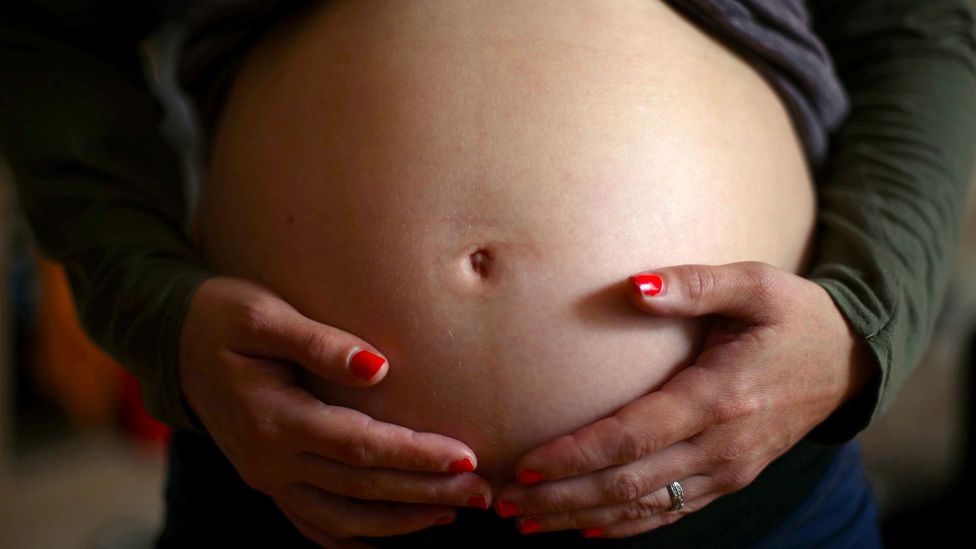
Mod medicine is already allowing women to have children far later on in life than their ancestors, but how far tin female fertility really be extended?
"It's one of nature's great inequities," says Dagan Wells, professor of reproductive medicine at the University of Oxford. He is referring to the progressive, and largely irreversible, decline in female fertility from the age of 35 years onwards.
Men also experience a decline in their baby-making ability as they get older, but this autumn in fertility tends to start later and occur much more slowly than in women. The fertility rate for men tends to begin falling effectually the age of 40-45 years old.
But when exactly does a woman's fertility start declining? And when does that decline issue in the finish of natural fertility?
For millennia, women have been getting pregnant and bearing children in their teens and early 20s – not much different from the Krapina Neanderthals, living in Northern Republic of croatia 30,000 years ago, whose fossilised remains suggest gave nascency to their first kid at 15 years of age. Prior to the 1960s, women in the U.s. were having their starting time child on average at effectually the age of 21.
You lot might besides like:
- The scientist who changed homo fertility
- What if women had total command over pregnancy?
- The outcome of childbirth no-i talks about
In 2017, however, the average historic period of mothers giving birth in all OECD countries was thirty. Only under half (44%) of all live births in England and Wales in the same year were to mothers aged xxx while the average age of women giving nativity to their first kid in Republic of korea was 31.
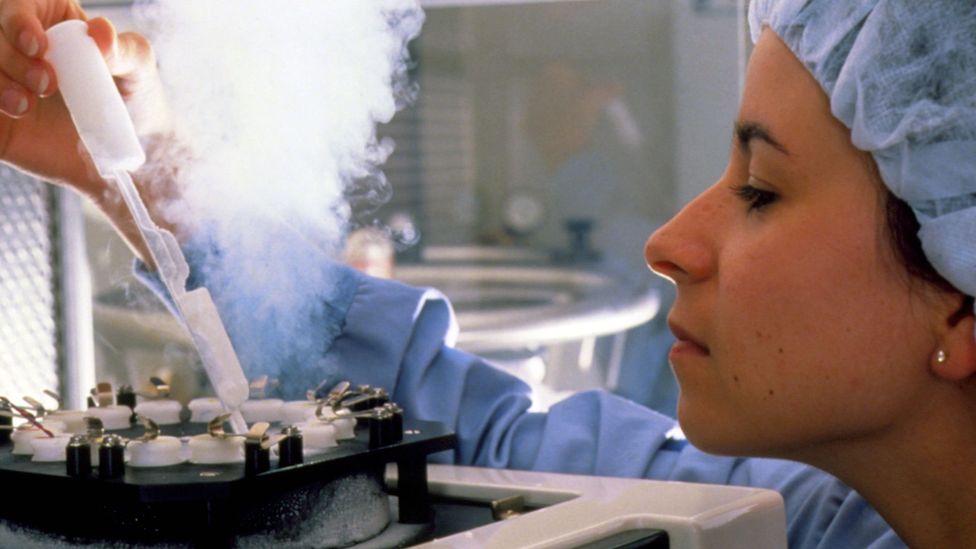
Fertility treatments and the power to freeze eggs has allowed more women to have children later than was possible in the past (Credit: Science Photo Library)
Merely what does this hateful in the context of the ticking clock of female fertility?
Numbers matter
For decades, scientists accept associated the reject in female fertility with the historic period-related decrease in the number of eggs contained within a adult female'southward ovaries. Each, if fertilised, has the potential to grow into a babe.
Unlike men, whose reproductive organs produce millions of fresh sperm on a daily basis, women are built-in with all the eggs that they will ever possess. Moreover, this number steadily declines as a adult female ages: from one million eggs at birth to 300,000 past puberty, 25,000 by the historic period of 37 and 1,000 by the historic period of 51. Of all these, however, just 300 to 400 eggs with babe-making-potential – normally merely one a month – will mature and eventually be released from a adult female's ovaries through ovulation across her unabridged life. For reasons not still fully understood, the balance undergo a natural process of degeneration and will never exist ovulated.
Most girls brainstorm menstruating between nine and xiii years of historic period, but their ovaries don't start releasing eggs until a to the lowest degree a year or two after. Unproblematic mathematics would suggest a adult female'due south egg supply would then typically exhaust itself around 33 years subsequently. And in most women, fertility does indeed tend to cease up to eight years before the onset of menopause, which for American women is around the time of their 51st birthday.
While such crude calculations do not accept the natural variability that can exist between women into account, or the fourth dimension windows during which ovaries might release more than one egg in a month, or months in which no egg is released at all, they tin can give a rough guess of merely how long the female fertility timeline tin be.
A more precise estimate of a woman's egg count, too known as "ovarian reserve", can be obtained by measuring the level of hormone chosen anti-Mullerian hormone (AMH) in a woman's claret. We at present know that AMH, produced by the ovaries of fertile, developed women, plays a vital role in the metamorphosis of an immature egg prison cell into a mature, hopeful egg, complete with all the biological prerequisites to create a healthy baby. Amend functioning ovaries, with larger egg stores, produce more AMH. Levels of the hormone decline as the timeline of female fertility progresses – average levels in 30 to 35 year olds are roughly two-thirds that of younger women while levels in women aged over 45 years are a quarter of those seen in women in their 20s.
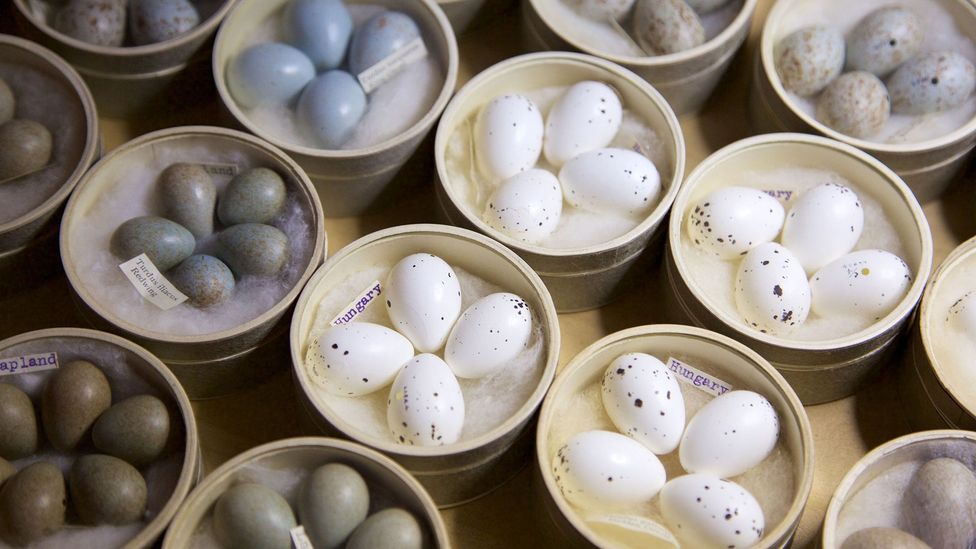
When they are born, women's ovaries already comprise all the eggs they volition ever produce (Credit: BBC)
Andrea Jurisicova, an embryologist at the Lunenfeld-Tanenbaum Research Institute of Mount Sinai Infirmary, has spent years studying the mechanisms that underpin the decline in female fertility with historic period, and investigating what can be done to slow this. Her research has institute that ovarian reserve is genetically regulated only that a woman's life experiences – such as stress, exposure to radiation or toxic chemicals and fifty-fifty those from when she herself was in the womb – determine egg numbers in after life.
Quality matters
But female fertility isn't just about the quantity of eggs. Quality matters likewise, and is much more technically challenging to assess than egg numbers. While egg counts decline as women age, so does the quality of the chromosomes and the Dna independent within each egg.
"Chromosomal abnormalities in human eggs are extremely mutual," says Wells. "Information technology's not something that should be considered to exist a particularly aberrant state of affairs, and in most cases its something that all women, even young women, volition have in their eggs at a low level but that level increases with advancing age."
For a woman in her 20s, a quarter of her eggs may exist expected to accept chromosomal abnormalities – this increases to up to xl% for a adult female between xxx and 35, and "goes up simply exponentially from there on". Beyond the age of 35, the frequency of these chromosomally abnormal eggs increases by 0.5% per month, so that for a adult female in her early 40s upward to 3-quarters of her eggs will have chromosomal abnormalities.
Having chromosomal abnormalities in her eggs doesn't necessarily hateful a woman is infertile, but they do mean that more than of her menstrual cycles will produce eggs that are less likely to produce a feasible baby.
Chromosomes are bundles of tightly coiled DNA that agree the genetic information needed for an organism to develop. A human egg contains 23 chromosomes – the half of your genetic code that comes from your female parent – which needs to combine with the 23 chromosomes from your male parent's sperm to develop into a viable embryo. An egg with also many or too few chromosomes, broken or damaged chromosomes will often neglect to develop properly. In some cases a babe can even so be born with chromosomal abnormalities, as happens with Down syndrome.
But most chromosomal abnormalities tend to be lethal to the extremely immature embryo, resulting in the embryo failing to implant in the lining of the womb or a very early miscarriage, oft between five and eight weeks of pregnancy.
While the take chances of chromosomal abnormalities is known to be higher in the eggs of older women, a recent European written report found that the level of chromosomal abnormalities is also loftier in younger women besides – from 13 into their early on 20s. The findings advise that female person fertility timeline follows a n-shaped pattern, with peak fertility observed in the mid-20s and lower levels of fertility both in very young and older women.
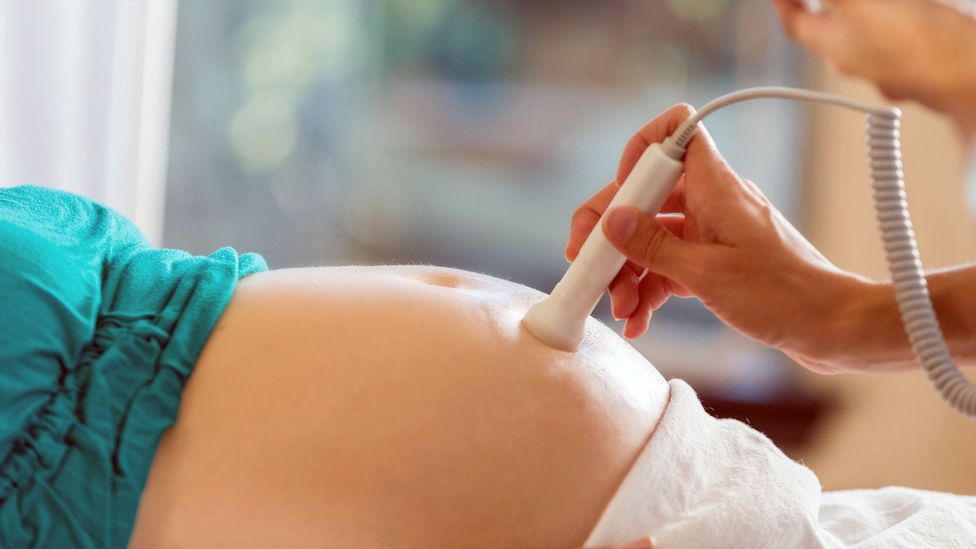
Older mothers may face greater risks during pregnancy, labour and delivery, but there are problems associated with older fathers too (Credit: Getty Images)
Elsewhere in the egg, faulty mitochondria – the tiny power stations that provide free energy for our cells and which nosotros all inherit from our mothers – can also exist a problem in older women. Studies have shown that up to half the eggs of women who are older than 35 carry mutations in their mitochondrial Dna, compared to a third of the eggs in younger women.
"An egg needs a threshold of near twoscore,000 mitochondrial DNA copies to brand an embryo," says Jurisicova.
For Wells, the show is articulate.
"The rate of decline accelerates around the age of 35 and the vast majority of women are substantially infertile past the time they reach 45," says Wells. "Importantly, this is years, maybe even a decade, before menopause. Everyone expects to be a little less fertile when yous are older, only the extent of that turn down takes a lot of people by surprise."
It would be wrong to focus simply on female person fertility. Some studies have shown that sperm quality also declines with historic period in men, starting in their 20s. Sperm mobility – the ability of it to swim around – has been found to pass up by effectually 0.7% every year while the sperm of older men carry more mutations in their Deoxyribonucleic acid. Older fathers too laissez passer on more mutations to their children than mothers do from their eggs.
Best egg
"The human being egg is a remarkable and unusual cell, it'due south the biggest cell in the body, and has a unique feature," says Wells. He is referring to the egg's ability to stop halfway through its growth and remain in a land of suspended blitheness for years, even decades, until it is eventually ovulated. His research suggests that it is the egg'southward ability to hold its chromosomes in a stable configuration during this period of hibernation that governs its power to brand an embryo and a baby.
Jurisicova's work adds some other piece to the puzzle. Her work suggests that human eggs undergo a process of growth and maturation within the ovary for at least 9 months before they are released during ovulation. "The quality of the egg released is the culmination of all the wellness and environmental influences on that growing egg over the by nine months," she says. Stress, exposure to radiation or toxic chemicals during this fourth dimension can have an agin effects on the developing egg.
Information technology is mayhap interesting that the duration of this incubation period – from when an egg emerges from hibernation and begins developing – uncannily resembles the number of months a babe spends within the womb before it is born. During this menstruum of maturation, the egg develops the resource information technology volition need should information technology be fertilised.
"The egg has to be extremely well resourced," says Wells. "For the first iii days following fecundation the embryo doesn't really make anything for itself – it doesn't transcribe its genes, it doesn't make proteins – its completely reliant on what the egg has provided for it. A more mature egg is more probable to be better resourced than a less mature one."
While there may be little that scientific discipline tin can practise to change the number of eggs that nature (or genetics) decides a woman volition have during her life, Wells and Jurisicova agree at that place are ways to meliorate, or rescue, egg quality. Adopting a salubrious lifestyle, exercising regularly, reducing stress and making sure that health problems such as hypothyroidism and other autoimmune conditions are well controlled can all help.

The range of factors pitched against an egg being fertilised and developing into a foetus make childbirth seem all the more incredible (Credit: Science Photo Library)
Jurisicova recently found that giving female person mice the antioxidant coenzyme Q10 delivers promising results – the mice that received the supplement produced improve quality eggs with more properly aligned chromosomes and better mitochondrial function. They were as well more than successful in producing alive babies, than the mice that did not receive the supplements. The results are, however, yet to exist replicated in humans.
The journey, not the destination
Mothers don't just need to debate with their fertility equally they go older, but too greater risks during pregnancy, labour and commitment. The Commencement and 2nd Trimester Evaluation of Risk (Faster) trial, a United states report funded by the US National Establish of Child Health and Human Evolution (NICHD), looked at the health records of over 36,000 women. They found mothers over twoscore were 2 to three times more likely to experience health issues during pregnancy including diabetes and high claret pressure. They were twice every bit likely to experience bleeding from their placentas, have a caesarean delivery and to lose their babe after in pregnancy.
The children of older first-time mothers who are forty years and in a higher place also have an increased risk of health bug at birth, such as depression nascency weight and congenital abnormalities. They too have a 50% increased run a risk of being born preterm and, perhaps consequently, are at increased risk of requiring neonatal intensive care afterwards nascence.
But this is still only one half of the equation. Older fathers likewise bring additional health risks for their children. Babies with older fathers are more likely to be born prematurely, take a lower nativity weight and higher risk of seizures. Some studies have also linked increasing paternal age to a greater risk of weather such equally autism and ADHD where the begetter is over the age of 40, only the testify remains inconsistent.
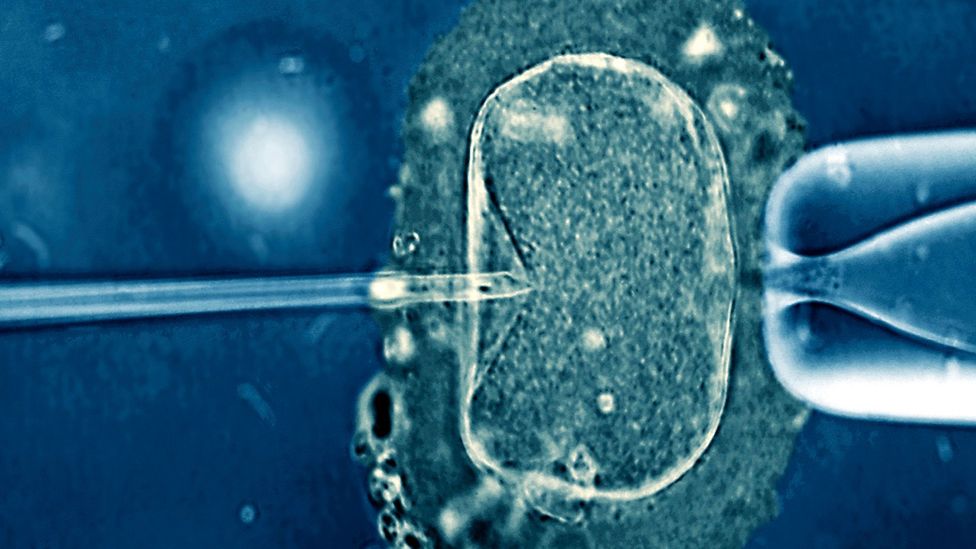
Scientists are developing new techniques to identify the best eggs for use in IVF treatments (Credit: Science Photo Library)
Is information technology possible to extend female fertility and for how long? Every bit is often the example, where nature creates inequity, science attempts to level the playing field. In September last year, Erramatti Mangamma, a 74-yr-old from southern India become the globe's oldest first-time female parent, delivering twin baby girls conceived via In Vitro Fertilisation (IVF) later 57 years of infertility. Three years ago, 72-year-old Daljinder Kaur, from northward India, gave birth to a son afterwards nearly five decades of marriage and ii unsuccessful IVF attempts.
The significant advances in reproductive medicine over the past decades have greatly increased the condom, success, accessibility and affordability of artificial reproductive techniques. Approximately 230 babies are built-in in the UK each year to women aged 50 and over while 9% of all kickoff-time mothers in the The states were aged above 35 in 2014.
But every bit we take seen, these techniques are still limited to a degree past the age of the egg. This is, not least, because of the effects of ageing on the Dna, but also because older eggs have been exposed to ecology toxins for a longer amount of time. It is possible, of form, for women to undergo IVF using a donated egg from a younger adult female. Nearly all fertility clinics across the world now besides offer women an option to store their eggs, frozen in time, until she is ready for them to exist thawed, fertilised and transplanted into her womb.
"The difficulties experienced with older women trying to take children is not related to the uterus only to the egg, and chromosomal abnormalities are at the heart of that," says Wells. "The egg is the seed rather than the soil. Many of the very early steps in homo development are determined past what the egg provides."
With the help of technologies like pre-implantation genetic testing, Wells and his fellow embryologists are developing means of identifying the best eggs that can be used in IVF treatments. Other techniques such every bit mitochondrial replacement therapy are as well helping mothers with defects in their eggs give birth to good for you children.
Only while science is making laudable steps to help prolong the ticking clock of female person fertility, information technology may non ever be possible to go along it going indefinitely. The decline of natural female person fertility is every bit inevitable as it is universal.
--
Bring together one million Future fans past liking the states on Facebook , or follow united states on Twitter or Instagram .
If you liked this story, sign up for the weekly bbc.com features newsletter , called "The Essential List". A handpicked pick of stories from BBC Future, Culture, Worklife, and Travel, delivered to your inbox every Friday.
Source: https://www.bbc.com/future/article/20200828-how-fertility-changes-with-age-in-women
0 Response to "A 45 Years Old Mom With Ivf Baby Is Likely to"
Post a Comment